Companion planting is a popular garden design technique that utilizes mutually beneficial interactions between compatible plants to cultivate a healthy, biodiverse garden ecosystem. Keep reading to discover the best companion plants for tomatoes. Companion planting will help you to grow healthier plants that produce tastier fruit and keep tomato pests away. Additionally, you’ll learn which plants should grow away from your tomatoes.
Many plants attract helpful pollinators and predatory insects that prey on garden pests, such as dragonflies, hoverflies, lacewings, ladybugs, and parasitic wasps. Other companion plants emit intense aromas that ward off animals and insects that might munch on your tomatoes.
Although extensive scientific research about companion planting has yet to be conducted, gardeners have employed companion planting strategies for many generations. However, more horticulturists have started analyzing plant interactions from a scientific perspective in recent years.
Are you ready to discover the best companion plants for tomatoes? Let’s dig in!
What Plants Grow Well with Tomatoes?

Tomatoes are some of the most popular garden veggies. However, even the most experienced gardeners sometimes need help with pest and disease problems. Companion planting, also called plant partnering, polyculture, or interplanting, is an excellent tool for natural pest and disease control.
Some of the most prevalent garden pests that damage tomato plants include aphids, root-knot nematodes, tomato hornworms, spider mites, and whiteflies. Numerous companion plants repel these insects through scent, while others attract their native predators.
Additionally, companion planting pairs plants that won’t compete for the same nutrients and growing space. Companion plants also help to suppress weeds, improve soil quality, attract pollinators, and reduce plant disease. To find out more about how companion planting benefits tomato plants, check out this article from AgriLife by Texas A&M University.
Companion Plants for Tomatoes That Attract Beneficial Insects
Insects play a vital role in creating a healthy and sustainable garden ecosystem. Most types of flowering plants need pollinators to bear fruit. However, even self-pollinating plants like tomatoes still benefit from the help of bees and butterflies. Numerous plants attract beneficial predatory insects that feed on garden pests and help keep bugs off tomato plants. Additionally, some plants are hosts where beneficial insects lay their eggs. Meanwhile, other flowers also act as food sources for omnivorous insects.
Bee Balm
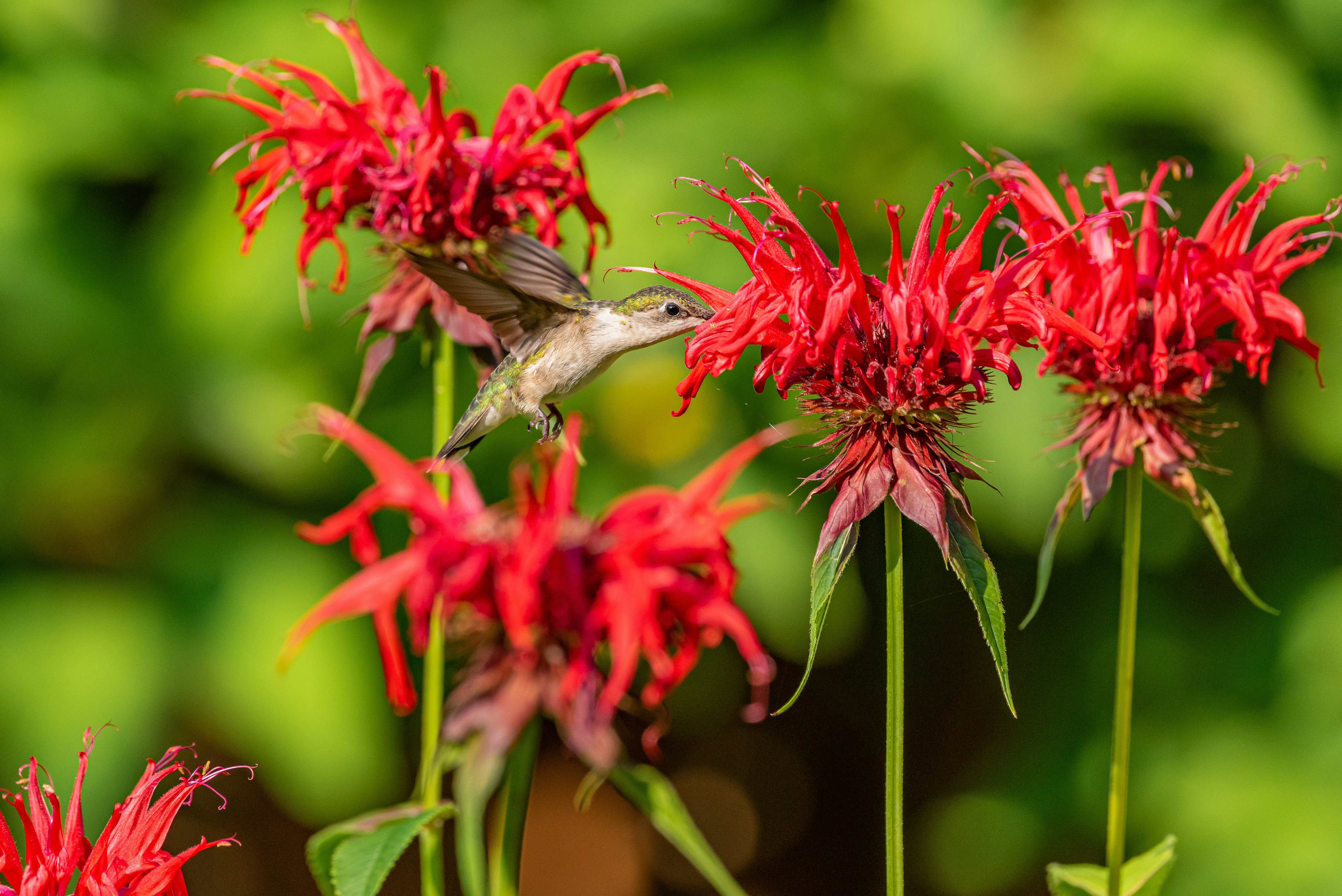
Bee balm, also called Monarda and bergamot, is a perennial flowering plant that’s a favorite of pollinators and predatory insects like bees, butterflies, hummingbirds, lacewings, and ladybugs. The plant’s potent aroma also repels common garden pests like aphids, whiteflies, and spider mites. In addition, bee balm reportedly improves the flavor, health, and vigor of tomato plants when cultivated nearby.
Borage
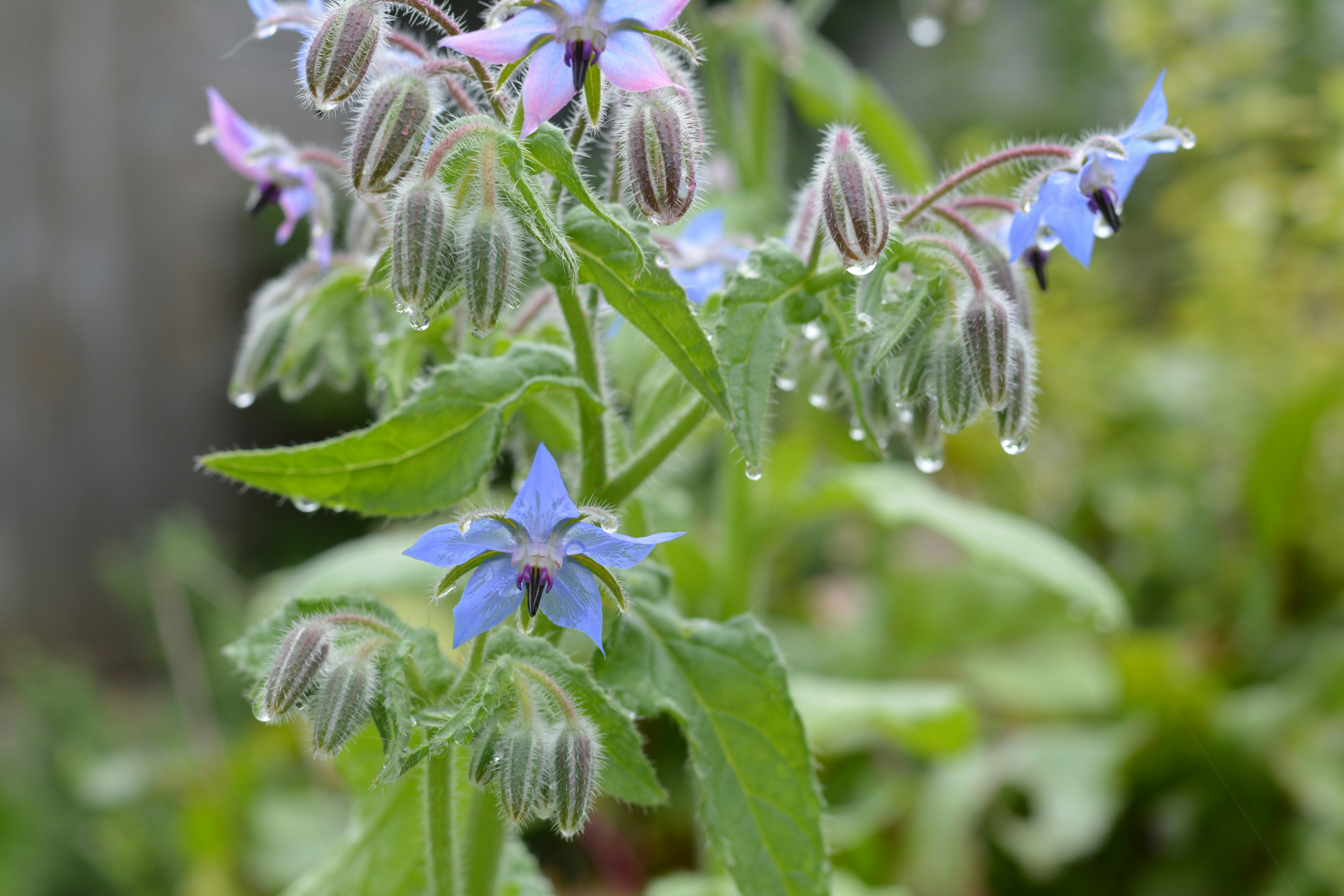
It’s a pollinator favorite, inviting bees and butterflies into your garden. Borage also appeals to beneficial predatory insects like parasitic wasps and lacewings that lay eggs on borage leaves. Furthermore, borage reportedly improves tomatoes’ flavor. It also helps nearby plants become more resilient against environmental stressors like drought, heat, and pest attacks. Large borage leaves also make excellent mulch around the vegetable garden. They add valuable nitrogen, magnesium, potassium, and other nutrients to the soil as they break down.
Borage is a fast-growing plant that gets large, around 3 feet tall by 2 feet wide, and freely self-seeds. As such, consider its space requirements when companion planting tomatoes nearby. If you don’t want volunteer seedlings next season, be diligent about removing spent flowers before they form seeds. Borage leaves and flowers are edible and have a sweet, cucumber-like flavor. The tender, young leaves are best for eating fresh, and older leaves are wonderfully flavorful when cooked like other leafy greens.
Calendula (Pot Marigold)
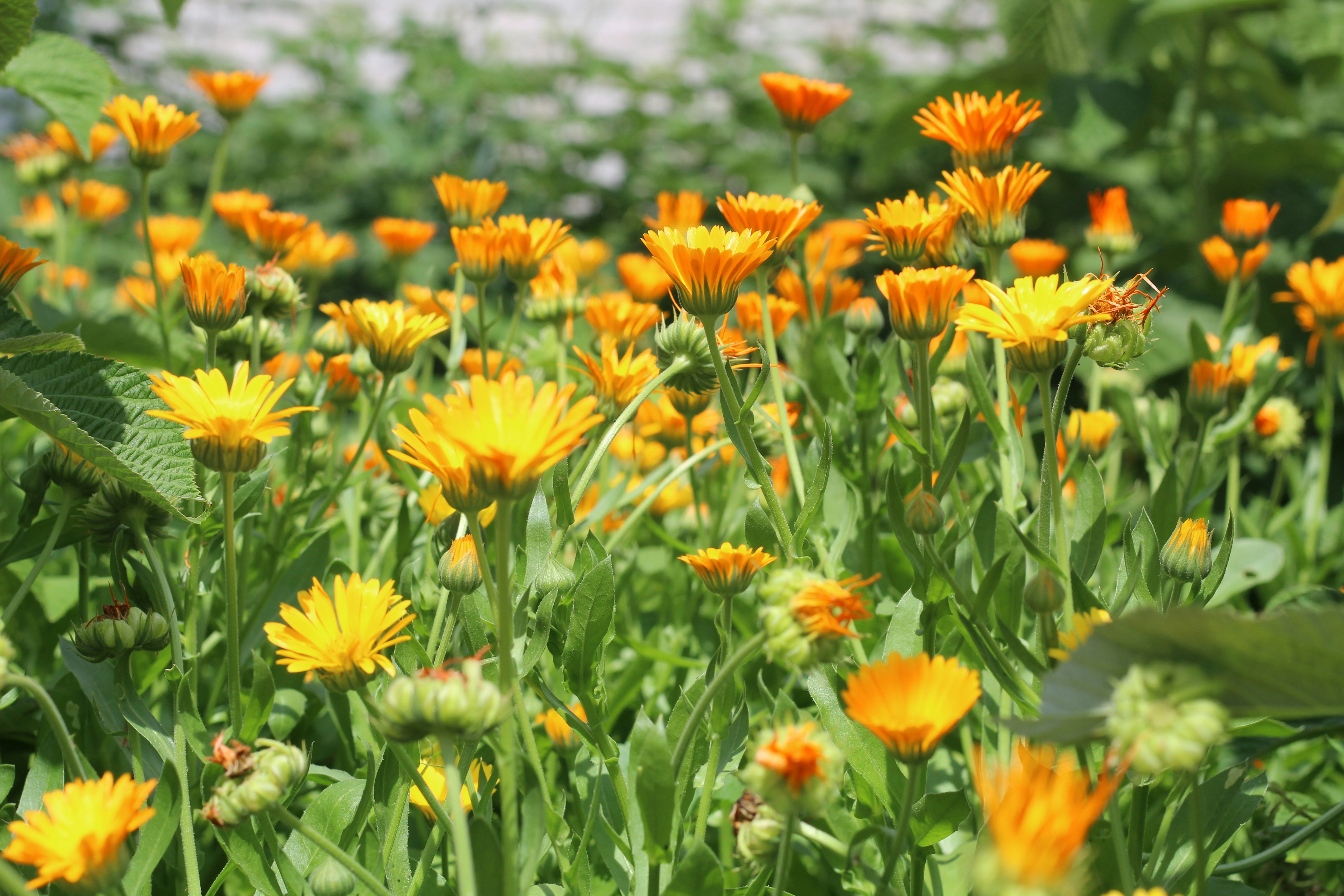
Calendula officinalis, also called pot marigold, is a fantastic tomato companion plant. The brightly-colored flowers attract a plethora of pollinators. Pot marigold is also an essential host plant for many predatory insects, including lacewings, ladybugs, and hoverflies. They feed on aphids, hornworms, whiteflies, thrips, and other garden pests in both their larvae and adult stages.
Dill
Dill (Anethum graveolens) is a garden herb with numerous culinary uses. It’s also incredibly beneficial for attracting beneficial insects to your vegetable garden. These include pollinators like bees, butterflies, and hoverflies, as well as predators such as ladybugs, lacewings, parasitic wasps, tachinid flies, and more.
These beneficial insects are primarily attracted to dill flowers. However, the herb freely reseeds itself when allowed. If you want to avoid volunteer dill seedlings next spring, prune the large flower heads before they produce mature seeds. If desired, dry and preserve dill seeds and use them in various recipes.
For the best results, plant dill at least 4 feet away from your tomatoes, as the mature plants exude growth-inhibiting chemicals from their root systems. Or, plant dill in a pot to enjoy the companion planting benefits without affecting nearby plants.
Oregano
Oregano is an incredibly helpful tomato companion plant in any home vegetable garden. Origanum vulgare attracts a wide variety of beneficial insects, from pollinators like butterflies and bees to predatory insects like ladybugs and lacewings. Its strong scent also repels pests like cabbage moths, carrot flies, and cucumber beetles.
However, you must allow your oregano plants to produce flowers to attract beneficial predatory insects. Additionally, this herb freely reseeds itself. Remove the flower heads before the seeds mature to minimize unwanted volunteer seedlings. The following season, transplant or compost any volunteer seedlings growing in unwanted places.
Parsley

Parsley (Petroselinum crispum) is a staple culinary herb for many classic tomato recipes. Also, it improves tomato plants’ overall health and flavor when grown nearby. Parsley also attracts beneficial predatory insects like tachinid flies and ladybugs, which feed on tomato pests like aphids, scale insects, and tomato hornworms.
Sweet Alyssum
Sweet alyssum (Lobularia maritima) is a fragrant and beautiful annual flower that attracts pollinators and beneficial predatory insects like hoverflies, ladybugs, and parasitic wasps to the garden. Planting sweet alyssum around the base of your tomato plant serves as a living mulch and helps retain moisture, suppress weeds, and protect the soil from erosion.
Companion Plants for Tomatoes to Keep Bugs Away
Perhaps you’re wondering what to plant with tomatoes to keep pests away. Numerous aromatic herbs and flowers double as natural bug repellents. Their strong odors can overpower the scent of other plants that insects like to feed on.
Plants have natural defense mechanisms to repel pests through their colors, fragrances, oils, and other natural compounds. Certain plants, such as garlic, have strong enough odors to disguise the scent of their companion plants. Some pests also get disoriented by bright colors and avoid the area.
Alliums
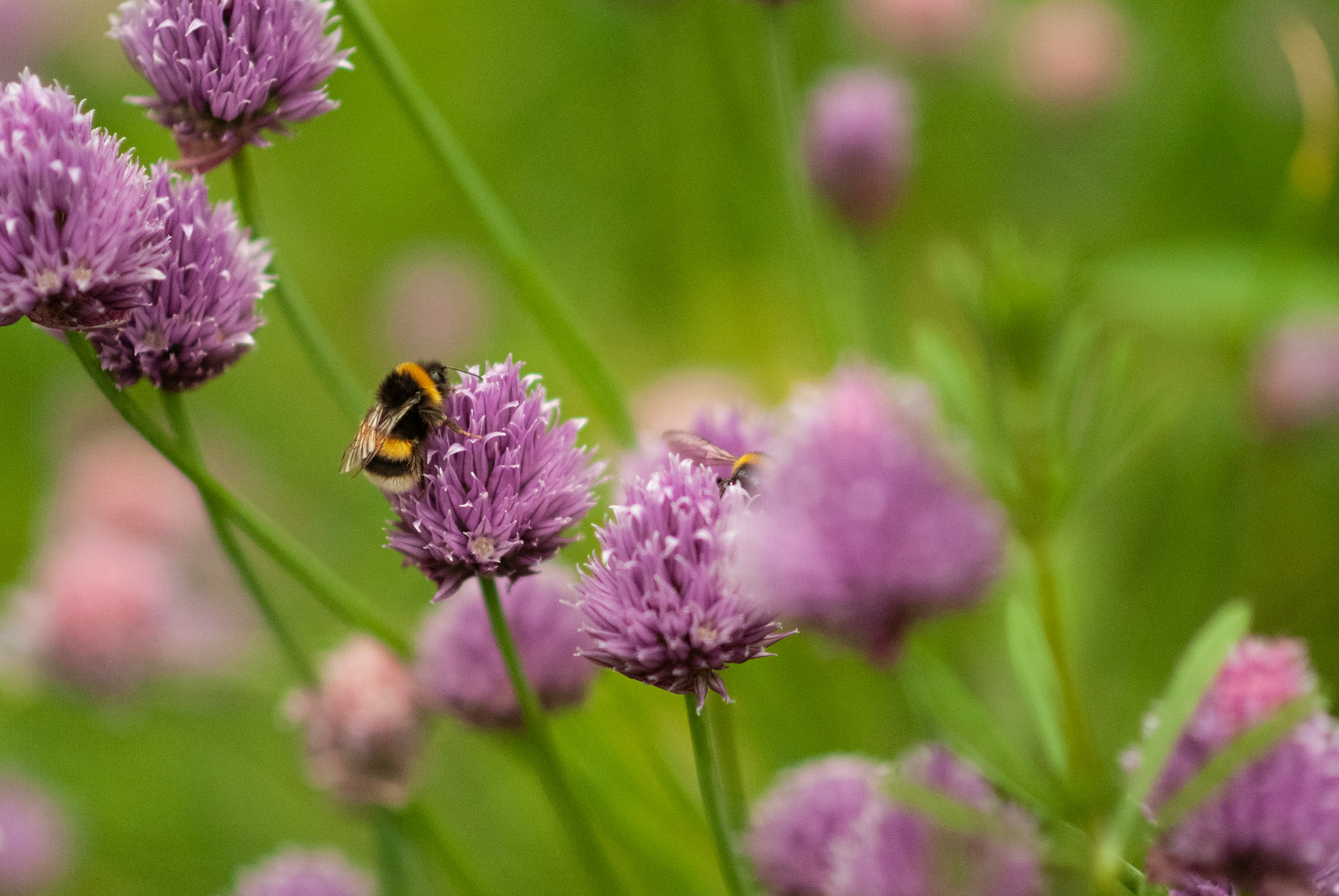
Allium plants effectively repel numerous garden pests thanks to their potent scent. Members of the allium plant family, or Amaryllidaceae, include chives, leeks, garlic, onions, scallions, and shallots. Alliums repel caterpillars, borers, aphids, armyworms, spider mites, slugs, and whiteflies as well as deer and rodents.
Avoid growing onion family members close to legumes like beans and peas. These plant groups reportedly stunt each other’s growth.
In addition to repelling pests, garlic has strong antifungal properties. Garlic spray controls fungal plant diseases like leaf spot, early and late blight, and powdery mildew. This spray is also an effective contact insecticide. However, be aware it will kill pests and beneficial insects like ladybugs, so be mindful of your little garden helpers when applying it.
DIY Garlic Spray for Insects and Fungal Plant Diseases
- 1 head of garlic
- 2 cups of water
- 1 tablespoon of bleach-free dish soap
- 2 tablespoons of mineral or vegetable oil
Peel the garlic, place the cloves and water in a blender or food processor, and liquefy. Let the mixture sit overnight. Then, strain out any remaining garlic pieces and pour the liquid into a clean spray bottle. Next, add the liquid dish soap and mineral or vegetable oil and shake the bottle vigorously to blend.
Spray all plant parts thoroughly, including both sides of the leaves. Fungal spores tend to emerge on the leaves’ undersides, and it’s also a favorite hiding spot for insects.
This DIY garlic spray is also an effective pest repellent. Use it wherever you notice significant pest activity in your garden. To avoid accidentally burning the plant’s leaves, it’s best to test home remedies like this on a small part of the plant first and monitor for any adverse reactions.
Asparagus

Tomatoes have a mutually beneficial relationship with asparagus plants. Solanine, a chemical compound in members of the nightshade plant family like tomatoes, eggplants, peppers, and potatoes, repels asparagus beetles.
In return, asparagus roots emit a natural nematocide, helping to control root-knot nematodes. This compound kills nematodes when they feed on asparagus roots, which decreases their population over time.
Basil

Tomatoes and basil are basically soul mates, both in the garden and on your plate. Basil (Ocimum basilicum) improves tomatoes’ flavor and helps the plants grow stronger. This fragrant herb also repels pests like asparagus beetles, armyworms, flies, mosquitoes, thrips, tomato hornworms, and whiteflies. Plus, its delicate flowers attract pollinators.
Marigolds
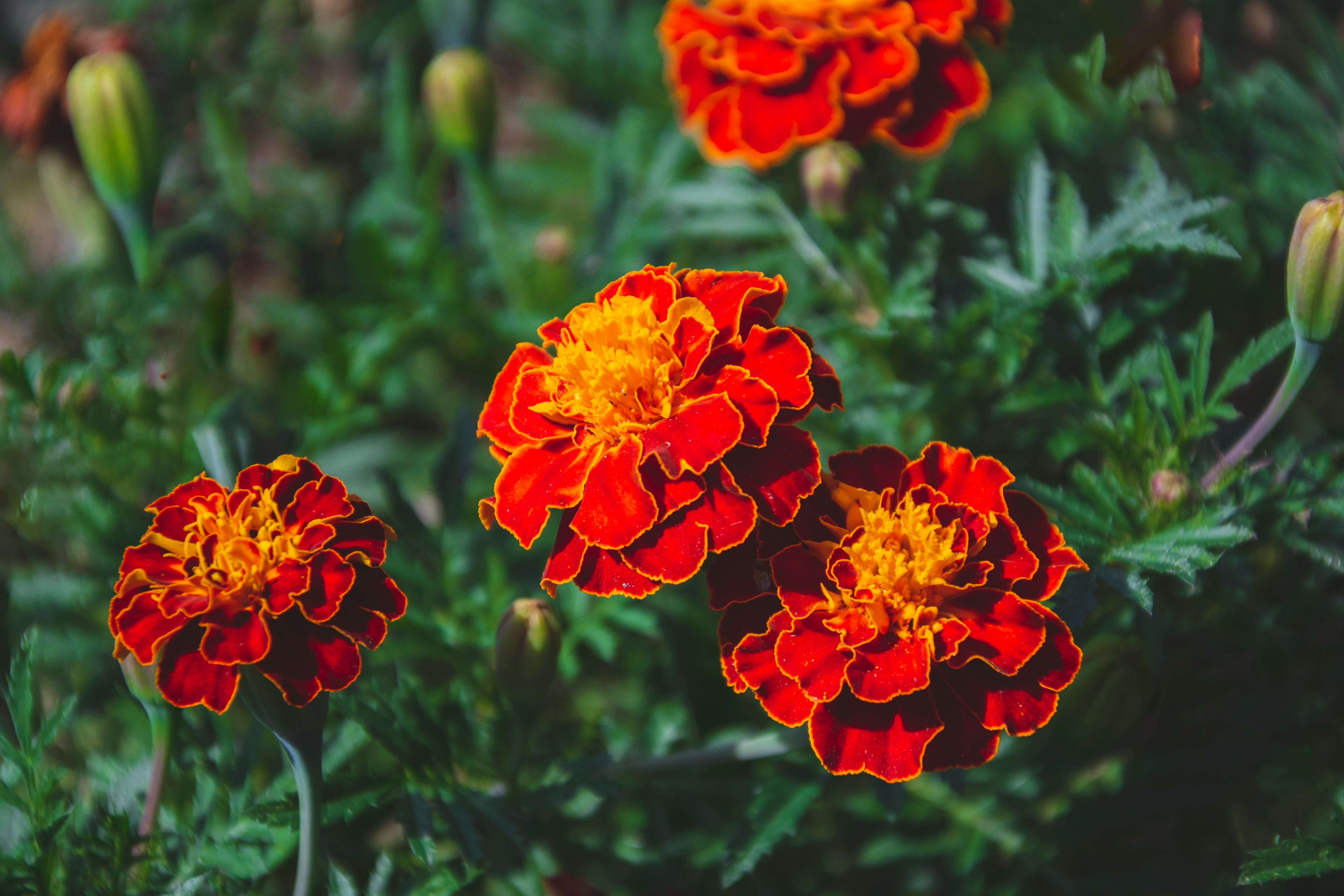
Marigolds are useful companion plants in vegetable gardens because of their pest-repellent qualities. French marigolds are reportedly the most effective variety for pest control. The plants’ roots contain a natural nematicide that kills nematodes when they feed, decreasing their overall population.
Additionally, marigolds’ pungent scent deters garden pests like cabbage worms, thrips, tomato hornworms, squash bugs, and whiteflies. Their colorful flowers also attract pollinators like bees and butterflies.
Companion Planting Tomatoes with Trap Crops
Some gardeners use a strategy called trap cropping to keep pests away from their plants. Grow something that pests prefer at a short distance from the veggies you want to protect. The insects will typically feed primarily on the trap crop and leave your precious tomatoes unharmed.
Once the trap plant is full of bugs, remove the whole plant and seal it in a plastic bag. Immediately dispose of it in a lidded outdoor garbage container. Or, place the bag in the hot sun for several days to kill all the insects inside, then add the plant material to your compost pile.
Nasturtium

Nasturtium plants attract aphids and can serve as a trap crop to keep these pests away from tomatoes and other veggies. Additionally, nasturtiums are host plants where numerous types of butterflies and predatory insects like hoverflies lay their eggs. When growing nasturtiums near tomatoes, be sure to give each plant plenty of space for its sprawling growth habit.
Nasturtiums have edible flowers and leaves with a bright, peppery flavor. They make a tasty and beautiful addition to fresh summer salads.
Radishes

Flea beetles can be problematic garden pests, eating holes in your plants’ leaves. They’re especially troublesome early in the growing season after transplanting young seedlings. Plant radishes near tomato plants as a natural deterrent for flea beetles, as they tend to prefer radishes over tomatoes. Regularly inspecting the radishes and removing infested plants will effectively reduce flea beetle populations and protect your tomato plants from their damage. Plus, radishes improve soil quality by breaking up compacted soil with their deep taproots and increasing water drainage and aeration.
Companion Plants for Tomatoes to Improve Soil Quality
Certain plant combinations have symbiotic relationships where one species provides specific benefits to another. Companion planting can help improve soil structure and biodiversity. As long as the plants are not competing for water, nutrients, or space (above as well as below ground), growing certain plants close together is more space-efficient and creates a healthy, interconnected garden ecosystem.
Together, these plants work synergistically, enhancing soil health by improving its structure, increasing organic matter, and fostering a diverse ecosystem of beneficial organisms such as earthworms and helpful microorganisms. This combination of improved soil fertility, drainage and aeration, and diversification contributes to healthier plants, higher yields, and sustainable gardening practices.
Bush Beans
Plants in the legume family, such as beans and peas, fix nitrogen in the surrounding soil through a symbiotic relationship with soil bacteria. They convert atmospheric nitrogen, which most other plants cannot absorb, into ammonium nitrogen and release it into the soil through their root systems. However, plant legumes separate from allium family members, as these plant groups stunt one other’s growth.
Tomatoes are heavy feeders and benefit from the extra nitrogen provided by legumes. Bush beans are an excellent fit because they don’t climb or need extra support, and they have a relatively compact growth habit. When companion planting tomatoes with bush beans, consider each plant’s mature size to ensure the tomatoes won’t block the beans’ sunlight. If possible, grow tomatoes on the north side of your bush bean plants.
Carrots
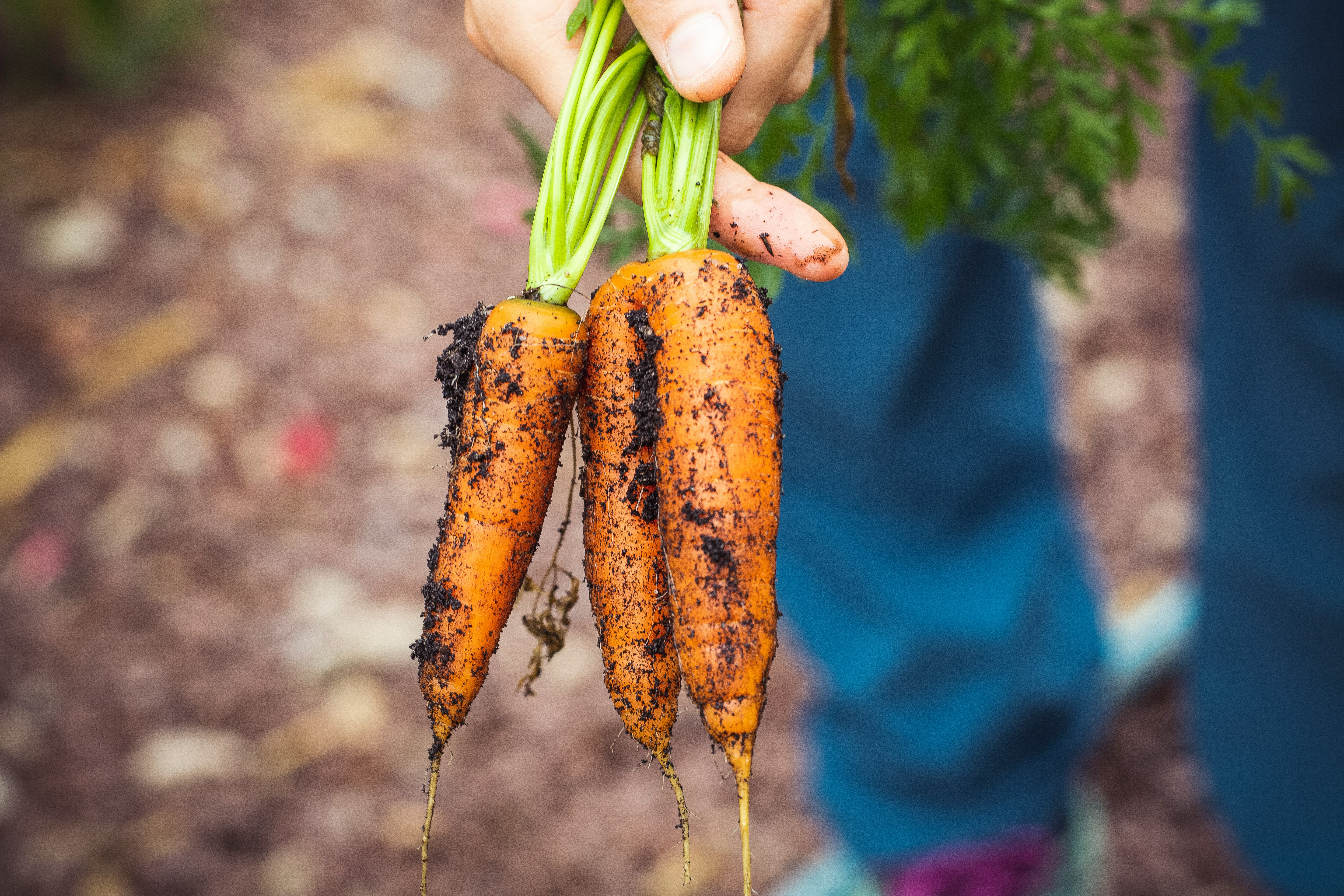
Carrots and tomatoes have a mutually beneficial relationship for several reasons. The long taproots aerate the soil around the tomatoes’ roots, facilitating better nutrient and water uptake. Carrot plants also attract predatory insects like parasitic wasps and soldier beetles that feed on garden pests like aphids and tomato hornworms.
In return, tall tomato plants provide much-needed shade for carrots during the summer heat. Tomato plants also produce a chemical called solanine that repels numerous carrot pests.
Leafy Greens

Leafy green veggies like lettuce, Swiss chard, and spinach serve as living mulch when grown between taller plants like tomatoes. They grow best with cooler temperatures and filtered sunlight, and the tomato plants shelter them from the intense summer heat and sunshine. In return, the low-growing leafy greens minimize weed growth and protect the soil, keeping it from drying out too quickly.
Practice succession planting for a continuous harvest of tasty salad greens throughout the growing season. Plant a second round of seeds two or three weeks before your first crop is spent. That way, the mature plants shelter the new seedlings as they emerge. When the seedlings are about three inches tall and have at least six leaves, carefully pull out the old plants so the fresh crop can grow.
What Not to Plant with Tomatoes
Some plants just don’t get along. Although limited scientific research is available concerning biological plant interactions, the topic has recently begun to attract more attention. Through their years of experience, generations of gardeners have found various plant pairings that apparently inhibit each other’s productivity and growth.
Many expert gardeners also recommend keeping plants that suffer from similar diseases and pest issues separate. That way, problems don’t tend to spread as quickly or become as severe.
Here are several plants not to grow near your tomatoes.
Brassicas
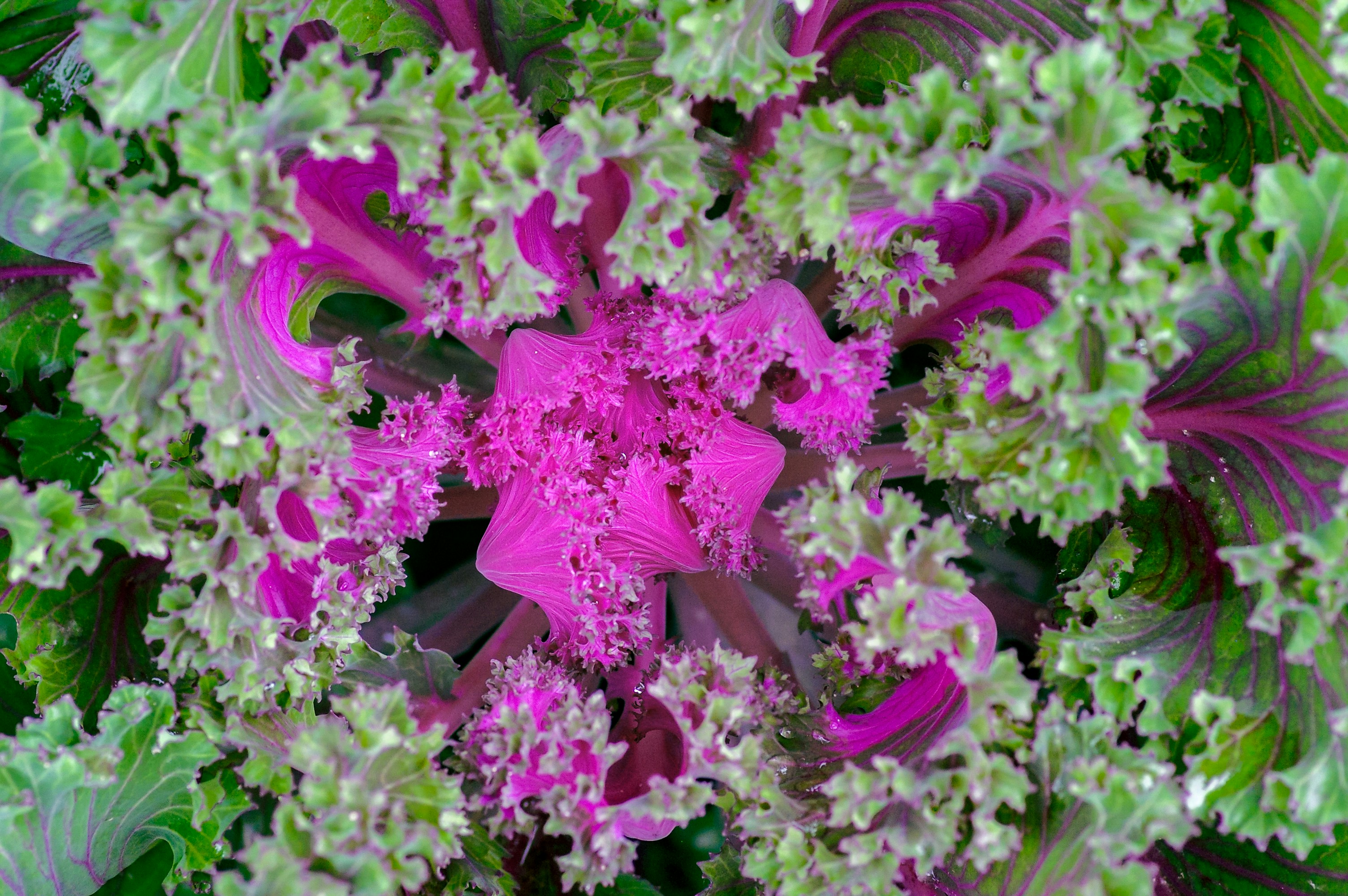
Brassicas don’t make good companions for tomatoes. Both types of plants are heavy feeders, meaning they’ll compete for nutrients if grown close together. As a general rule, plant brassicas at least three feet away from your tomatoes or in a separate raised bed. The Brassica plant family includes cole crops like arugula, broccoli, Brussels sprouts, bok choy, cauliflower, collard greens, kale, kohlrabi, rutabaga, and turnips.
Corn
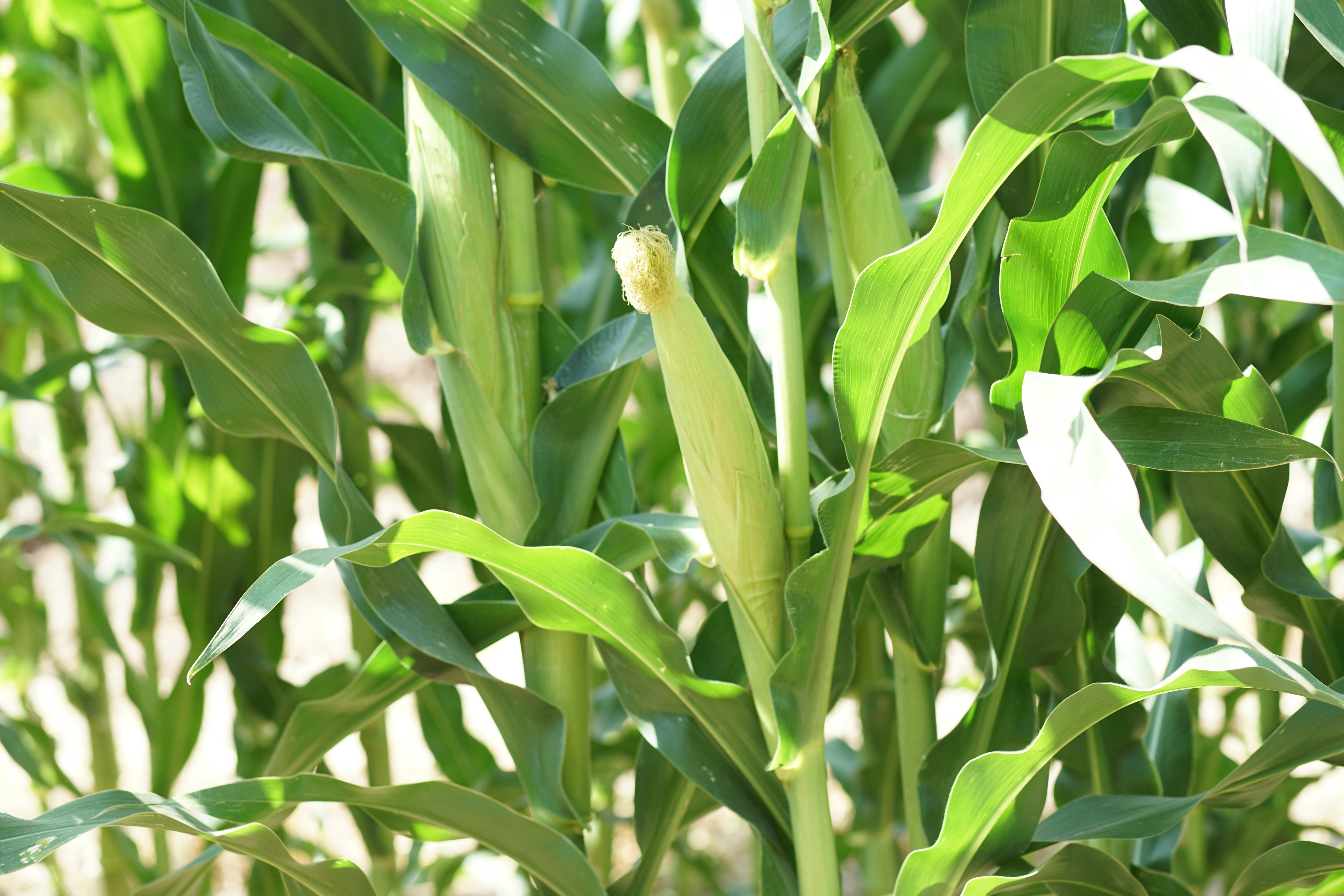
Tomatoes and corn have a common insect enemy: the corn earworm, also known as the tomato fruitworm or Heliothus zea. These moth larvae can be incredibly destructive in the garden. It’s generally best not to grow plants prone to the same pest and disease problems close together.
Fennel
Fennel (Foeniculum vulgare) attracts numerous beneficial insects, including pollinators and predators. Unfortunately, it doesn’t get along very well with most other types of plants, including tomatoes. Fennel plants are allelopathic, meaning secrete growth-inhibiting chemical compounds from their root systems.
Nonetheless, you can still enjoy fennel’s companion planting benefits without harming your other plants. Grow fennel in a container placed in your veggie garden or next to your raised beds. Or, plant it in a secluded corner of the garden where it’s at least five feet away from other plants.
Other Nightshades
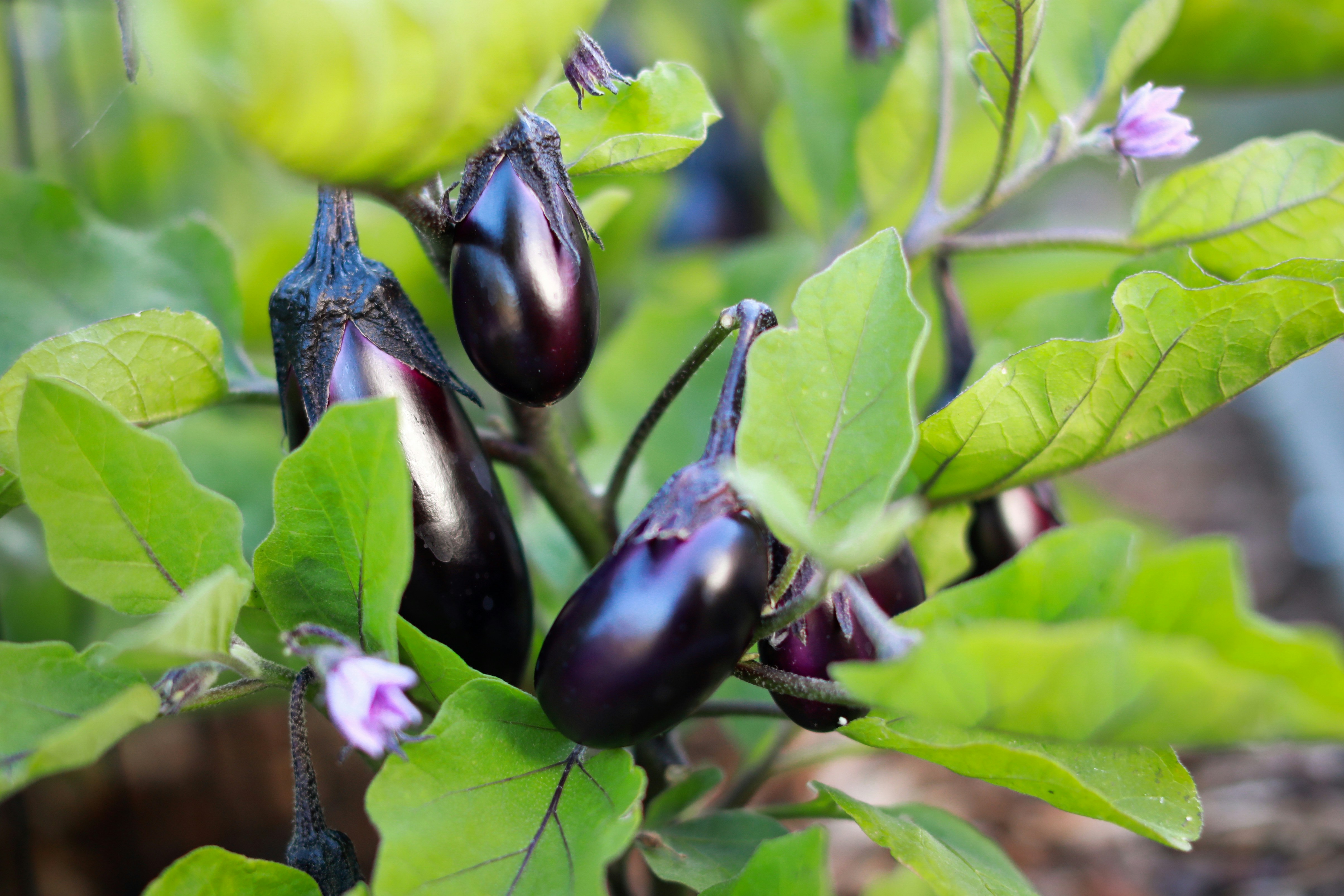
The Solanaceae or nightshade family includes edible crops like eggplant, peppers, potatoes, and tomatoes. Since plants in the same family tend to have similar pest and disease issues, it’s best to avoid growing them in the same area of your garden. In fact, doing so can increase the risk of quick-spreading disease issues like early and late blight and potato blight, which also affect other nightshade varieties.
These pathogens accumulate in the soil if the same type of plant grows in the same place each year. As such, regular crop rotation is beneficial. That means changing where you plant different crops every two or three years. Crop rotation also helps replenish nutrient levels in the soil, as different plants use varying kinds of nutrients.
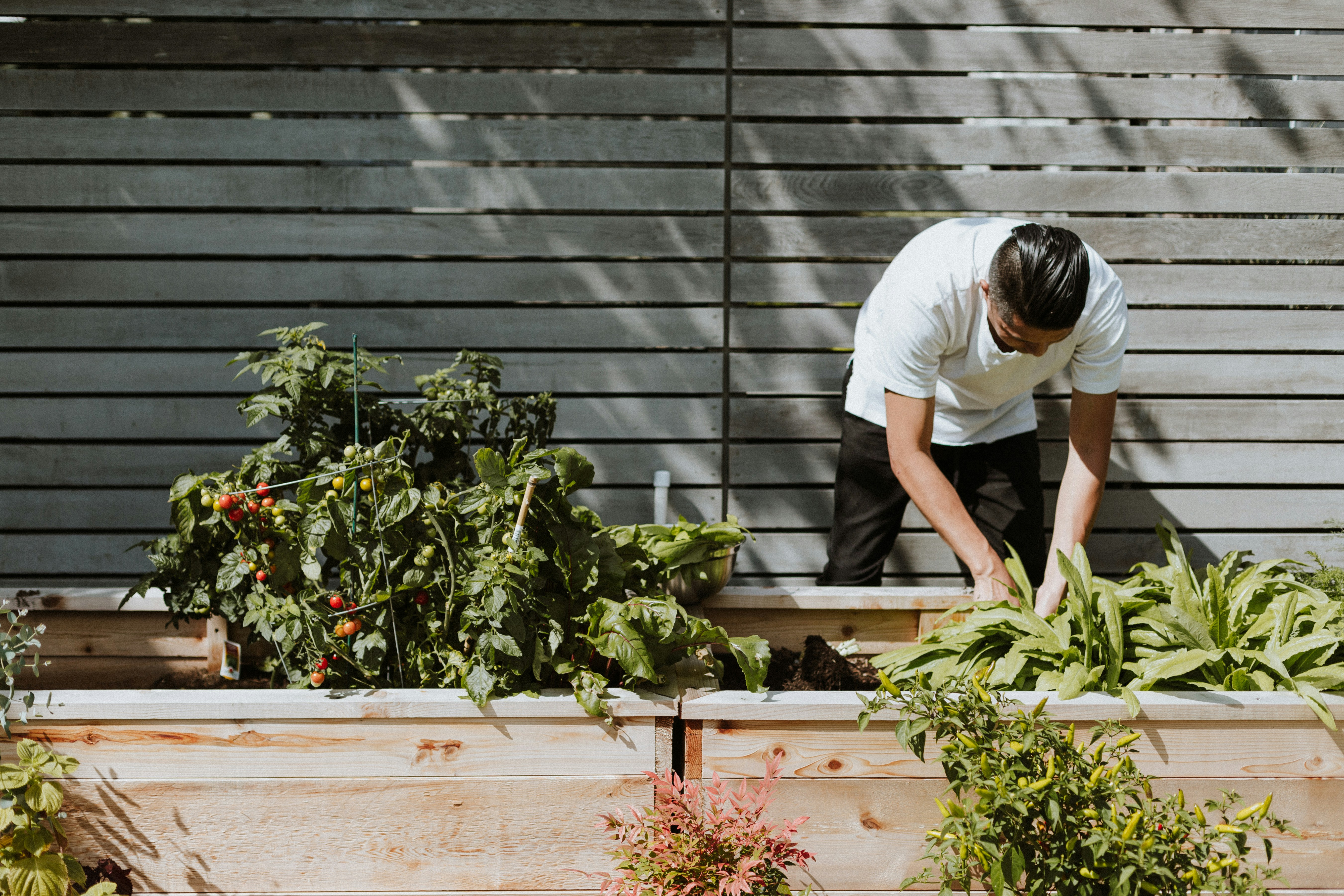
Companion planting tomatoes with these herbs, flowers, and vegetables will attract beneficial pollinators and predatory insects and repel garden pests. You’ll be less reliant on fungicides, pesticides, and other treatments, creating a naturally healthy and eco-friendly garden environment. By imitating how nature works, many generations of gardeners have found a more natural and sustainable way of enjoying an abundant veggie harvest year after year.
Do you have any questions or suggestions about companion plants for tomatoes? Please share them in the comments! If you found these companion planting tips useful, don’t hesitate to share this post about what to plant with tomatoes with your fellow green thumbs.
